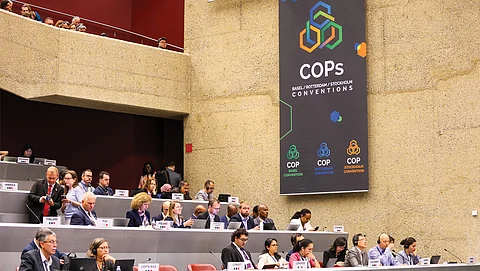

Every two years, close to 200 countries, including India, attend the Conference of the Parties (COP) to the Stockholm Convention with the goal of eliminating or reducing harmful and persistent chemicals. However, during the latest negotiations in Geneva, Switzerland, held on April 28-May 9, the Parties decided to allow use of UV-328, an industrial chemical, in the aerospace and defence sector. In 2023, the Parties had decided to ban it, except in certain applications in five sectors—motor transport, instrumentation, industrial machines, medical and photography.
UV-328 is in production since the 1970s and is widely used in paints and plastics as an ultraviolet ray absorber to protect surfaces against discolouration and degradation under sunlight. It can be toxic to the liver and affects hormones. The decision to allow its use in another sector raises doubts about the credibility of the crucial treaty that came in force in 2004. Stockholm Convention is a global treaty to protect human health and the environment from persistent organic pollutants (POPs). POPs like UV-328 have four key traits: they persist in the environment for long periods; travel globally and become widely distributed geographically; accumulate in the fatty tissue; and are toxic. Evidence on UV-328’s POP traits emerged only in the 2000s, with the chemical being found in the environment and living organisms, including in remote areas such as the Arctic Ocean, far from its production and use.
Despite the concerns, its production grew, and it was designated as a high production volume chemical (greater than 1,000 tonnes per annum) as of 2021, according to the Organisation for Economic Cooperation and Development’s Existing Chemicals Database. Given these concerns, in 2020, Switzerland proposed to list UV-328 in Annex A to the Stockholm Convention. The convention has three annexes: Annex A lists chemicals to be eliminated; Annex B lists chemicals whose production and release are restricted; and Annexe C lists chemicals whose unintentional production and release need to be minimised.
“Parties began implementing the ban and then one country [Ethiopia] made a proposal to include new exemptions for UV-328. This is really questioning the credibility of the Convention, and the decisions that are taken,” Giulia Carlini, manager and senior attorney, Environmental Health Program at the Center for International Environmental Law, a Washington-based non-profit law organisation, tells Down To Earth (DTE). This decision is “unprecedented”, she adds.
Others share similar concerns. Therese Karlsson, Science and Technical Advisor at International Pollutants Elimination Network (IPEN), a Sweden-based global network of public interest organisations, tells DTE that this decision might make it easier for countries and industries to view listing as not final.
The 2025 Geneva COP also adds three new POPs under Annex A—chlorpyrifos; long-chain perfluorocarboxylic acids (LC-PFCAs), their salts and precursors; and medium-chain chlorinated paraffins (MCCPs). Though this is a seemingly good move, the exemptions to their use have been made without due diligence, say experts. “A lot of exemptions were introduced at the COP without having gone through any kind of scientific review,” says Karlsson.
Take the case of chlorpyrifos, an insecticide widely linked to neurodevelopment issues. Chlorpyrifos was set to face a ban (with a few exemptions) under the Convention in 2025. But some countries, including India, called for more exemptions, citing food security concerns.
Similarly, MCCPs were to be banned this year, but nations agreed to the ban after many additions were made to the already-long list of ex-emptions. MCCPs is a family of industrial chemicals used to make plastics flexible and durable. It is used in polyvinyl chloride (PVC) products, as well as in paints, sealants and rubber. These chemicals likely adversely affect the liver, kidneys and the thyroid gland. Lastly, LC-PFCAs—forever chemicals used in cookware and associated with cancer—were added to Annexe A but only after certain tweaks to reduce the impact of the ban.
In recent years, the number of new chemicals listed under Annexe A has dropped and the number of exemptions and the timeline for their allowed production and use has increased. As per a 2023 analysis by IPEN, in 2001-11, nations added 18 chemicals or chemical classes in Annex A. But in 2012-22, only eight chemicals were added. The analysis also found that more exemptions were added in the second decade.
The other issue is that a global ban under Stockholm Convention applies only when countries choose to do so, giving them the option to opt out. On March 28, 2006, India declared that any amendment to Annex A, B or C “shall enter into force only upon the deposit of its instrument of ratification, acceptance, approval or accession with respect thereto”. Close to 20 countries make the same declaration. For example, India has not ratified, accepted, accessed or approved most POPs under Annex A. Only in 2021, the country implemented the first set of eliminations, covering seven of the 33 chemicals under Annex A.
This article was originally published in the June 1-15, 2025 print edition of Down To Earth